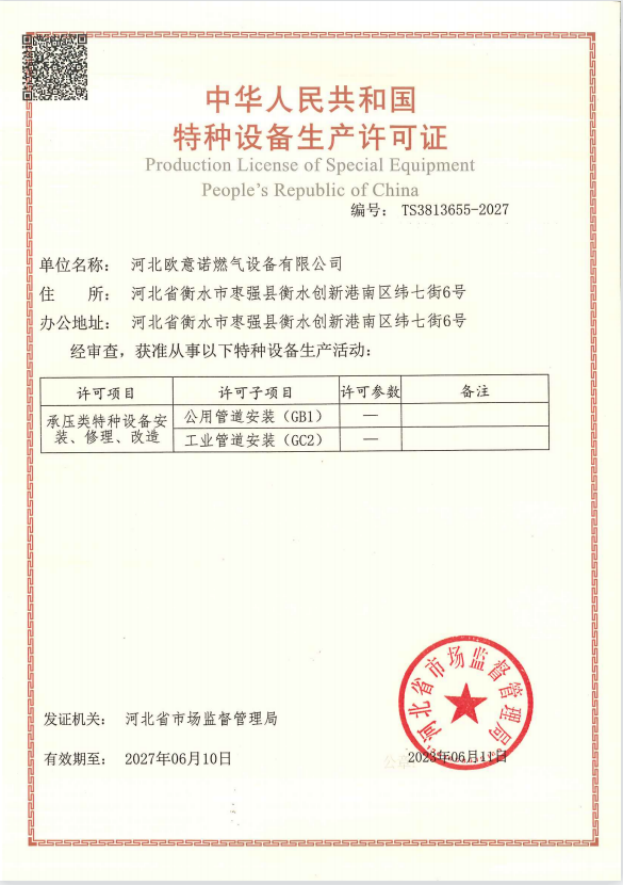
Nov . 27, 2024 21:05
Back to list
Natural Gas Pressure Reducing Valve for Efficient Energy Management
Understanding Natural Gas Pressure Regulators
Natural gas has become an essential energy source worldwide, powering homes, industries, and even vehicles. However, the delivery of natural gas requires careful management of its pressure to ensure safe and efficient use. This is where natural gas pressure regulators come into play. These devices are crucial for controlling the pressure of gas as it moves from high-pressure transmission lines to lower-pressure distribution systems, making them indispensable in the natural gas supply chain.
What is a Natural Gas Pressure Regulator?
A natural gas pressure regulator is a mechanical device designed to reduce the pressure of natural gas as it enters a residential or commercial building. Typically located near the meter or in a gas main, the regulator ensures that the gas delivered to appliances operates safely within specified pressure ranges. If the gas pressure is too high, it could damage appliances, pose safety hazards, or lead to inefficient combustion.
How Do Pressure Regulators Work?
The operation of a gas pressure regulator is based on a simple principle of maintaining a constant output pressure despite varying input pressures. Inside the regulator, there is a diaphragm that reacts to changes in gas pressure. When the gas enters the regulator, it exerts pressure on one side of the diaphragm. If the input pressure is too high, the diaphragm moves, opening a valve that allows excess gas to escape, thereby reducing the output pressure to a pre-set level.
.
Types of Pressure Regulators
مخفض ضغط الغاز الطبيعي

There are generally two types of natural gas pressure regulators first-stage and second-stage regulators. First-stage regulators are used in high-pressure systems to reduce the pressure of gas coming from the transmission lines. They lower the pressure significantly before it moves further into the distribution system.
Second-stage regulators further decrease the pressure before the gas enters a building or gas appliances. They fine-tune the output pressure to the safe and operational level required by residential or commercial users. Together, these two types of regulators ensure that gas is delivered safely and effectively.
Importance of Pressure Regulation
The importance of natural gas pressure regulators cannot be overstated. They enhance safety, efficiency, and reliability in gas delivery systems. By ensuring that gas is delivered at the correct pressure, regulators help prevent dangerous situations such as leaks or explosions. Furthermore, maintaining the proper pressure can improve the efficiency of gas appliances, leading to better performance and lower energy costs for consumers.
Also, with the increasing focus on environmental sustainability, pressure regulators can play a role in reducing gas wastage, ensuring that natural gas—which is often viewed as a cleaner alternative to other fossil fuels—is used as effectively as possible.
Conclusion
Natural gas pressure regulators are vital components of our gas distribution systems. They enable the safe and efficient delivery of natural gas and are crucial for healthcare, manufacturing, and many other vital services. As energy needs continue to evolve, the role of pressure regulators will be increasingly important in ensuring that we can meet those demands safely and sustainably. Understanding how these devices work can help consumers appreciate the complexities of the systems that deliver energy to their homes and businesses, and ultimately, contribute to a safer and more efficient energy landscape.
Latest news
-
Safety Valve Spring-Loaded Design Overpressure ProtectionNewsJul.25,2025
-
Precision Voltage Regulator AC5 Accuracy Grade PerformanceNewsJul.25,2025
-
Natural Gas Pressure Regulating Skid Industrial Pipeline ApplicationsNewsJul.25,2025
-
Natural Gas Filter Stainless Steel Mesh Element DesignNewsJul.25,2025
-
Gas Pressure Regulator Valve Direct-Acting Spring-Loaded DesignNewsJul.25,2025
-
Decompression Equipment Multi-Stage Heat Exchange System DesignNewsJul.25,2025

